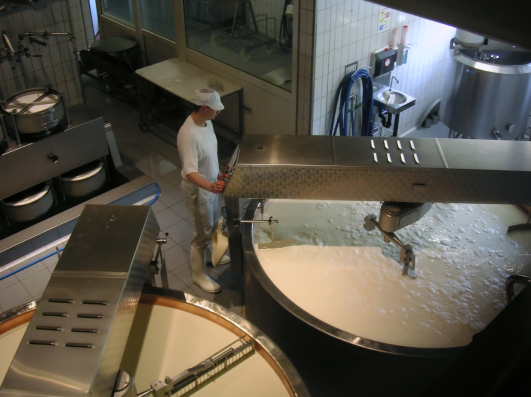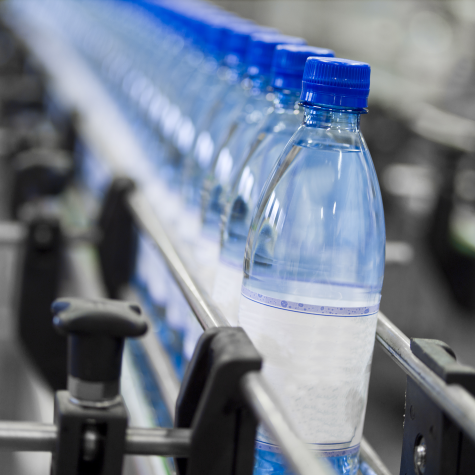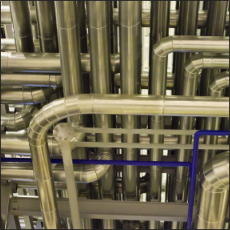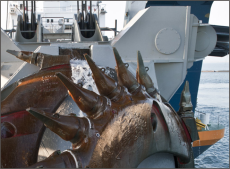Food & Beverage Projects
Development and installation of a batch control system using ISA S88.01 compliant batch software
SUMMARY: Used a programmable logic controller (PLC) and batch control software that is compliant with the ISA S88.01 batch control standard to control a batch process for a food flavorings manufacturer.
DESCRIPTION: The batch control software utilizes a client-server model with the server controlling the scheduling and running of batches and the clients providing the operator with the ability to control and monitor the batches. The batch server communicates with the PLC to control the batch process. The PLC contains all the phase logic required to control the various batch process equipment. Developed the physical model representing the batch process equipment and typical recipes for various batch processes. Developed all the PLC phase logic. Developed custom graphic screens using human machine interface (HMI) software to provide operators with a graphical representation of the batch process. Integrated the various pieces of the batch control system (batch server, batch clients, HMI, PLC) to ensure proper system functionality.
Juice Blending/Batching system consisting of a PLC and HMI

SUMMARY: Designed, developed and installed an automated juice blending and batching system. The system consists of two batch tanks where dry ingredients are dissolved in water, six storage/blending tanks to where the batches are pumped, with additional water and sugar added. During the packaging process, the liquids are pumped through proprietary blending systems with the final product being sent through HTST presses and on to bottling lines.
DESCRIPTION: Blending consists of batching fixed quantities of water to a choice of two small blending tanks. Using an Operator Interface Terminal, the operator selects the destination tank, the volume of water, and the temperature of the batch. The system automatically dispenses the correct amount of water and heats the tank to the correct temperature. At then end of the blending, the operator selects one of six storage/blend silos. Because the tanks share piping, the system determines the correct path, avoiding cross contamination, and pumps the batch to storage. Once in storage, the operator may add additional water and/or sugar. Both are batched by volume, with a choice of three sugar sources. Again, because of shared piping, the system must insure that there is no cross contamination. The package operation requires the PLC system to reliably interface to a proprietary blending system. The PLC controls the stop/start of the entire system, including the valve nests that send the product to the HTST and then on to the fillers. The system also has a CIP cycle that allows for “selected partial system” CIP. The operator selects the section of the piping to be cleaned, prepares the tanks with the proper chemicals, and the system proceeds to execute the CIP program.
Dairy Creamery Automation

SUMMARY: Designed, developed and installed a PLC/MMI system to automate the process of batching/blending milk, pasteurizing and step-heat processing for the making of sheep cheese. The process also included waste handling and CIP.
DESCRIPTION: The system employs a PC based MMI for operator control of the process, which allows for the creation of recipes for several of types of cheeses. Some of the parameters include milk (sheep, cow, both, frozen), batch size, and inoculants. At process time, the operator selects a recipe, is prompted for and must confirm that the piping is properly connected, and then presses the ‘Start’ button on the screen. The system then controls the volumetric addition of milk to the processing vat. Once the milk is added, heat is applied according to the recipe profile. If frozen milk was used, there is a ‘thaw’ cycle that is performed before the heat treatment cycle. A separate recorder certifies pasteurization, but the cycle is controlled by the PLC. During the process, the operator is prompted to add inoculants. These prompts include the description and weights of the items to add, which can be rennet, mold cultures, acids and other items required to create the curds. The PLC controls the valves for heating and cooling of the process vat. Alarms conditions are monitored and displayed to the operator. Temperatures are trended. There are 10 selectable CIP processes, each of which cleans a distinct portion of the system. The system automatically controls additions of water, soap and acid for the complete process.
Downtime Collection and Reporting system for Juice Line
SUMMARY: Developed HMI and Visual Basic front end to create real-time networked display of Juice Line status as well as automatically collect actual downtime reasons with time stamp.
DESCRIPTION: Each of the 22 PLCs on the line required additional code to determine actual downtime. Care was taken to avoid collection of erroneous faults. The human machine interface (HMI) provided management with a real-time visual view of the Juice Line machinery status, faults, efficiencies and production. Additionally, Visual Basic and MSSql was used to collect downtime, efficiencies and production. An automatic downtime and production report is created daily. The report is saved on the main server for management to view. Several of the office computers are set up as clients to view the real-time graphics, status and alarms. The custom Visual Basic query form also resides on each client. This enables management to select, sort, view and print downtime information in a customized report format.
Control system development for five new conveying lines in bottling plant

SUMMARY: Used five programmable logic controllers (PLCs) to control table-top conveyors (for loose bottles) and full-case conveyors (for packaged bottles) for five new bottling lines.
DESCRIPTION: The five new bottling lines use table-top conveyor to convey loose bottles from the fillers to the case-packers and full-case conveyors to convey cases from the case-packers to the palletizers. Using photoeyes and accumulation control logic, the PLC controls the conveyors to maintain product flow and avoid backups. A plant floor device network is used between the PLC and the variable frequency drives (VFDs) for start/stop and speed control. Messaging between PLCs and a supervisory PLC is accomplished through a gateway.
Control system ammonia refrigeration system
SUMMARY: A programmable logic controller (PLC) and operator interface terminal (OIT) were used to control the suction and discharge pressures of an ammonia refrigeration system for a cola bottling facility.
DESCRIPTION: Eleven ammonia compressors, each with a number of unloading solenoids, are controlled by the PLC in order to maintain compressor suction pressure. Two condenser units, each with two two-speed fans, are controlled by the PLC in order to maintain compressor discharge pressure. As the plant filler starts and stops, the PLC loads and unloads the compressors and sequences the condenser in order to provide consistent cooling capacity to the filling process. Through the OIT, the operator can change setpoints and view process status.
Control system upgrade for palletizer in bottling plant
SUMMARY: Upgraded a palletizer PLC control system from one style PLC to another.
DESCRIPTION: The palletizer used an old style PLC for machine control and an operator interface terminal (OIT) for pattern selection. The program was converted to a new style PLC program, requiring restructuring of the program layout and development of new file structure for pattern storage. An interface to a case conveying system was modified to allow multiple products to be palletized based on the UPC code being scanned by a barcode reader.












